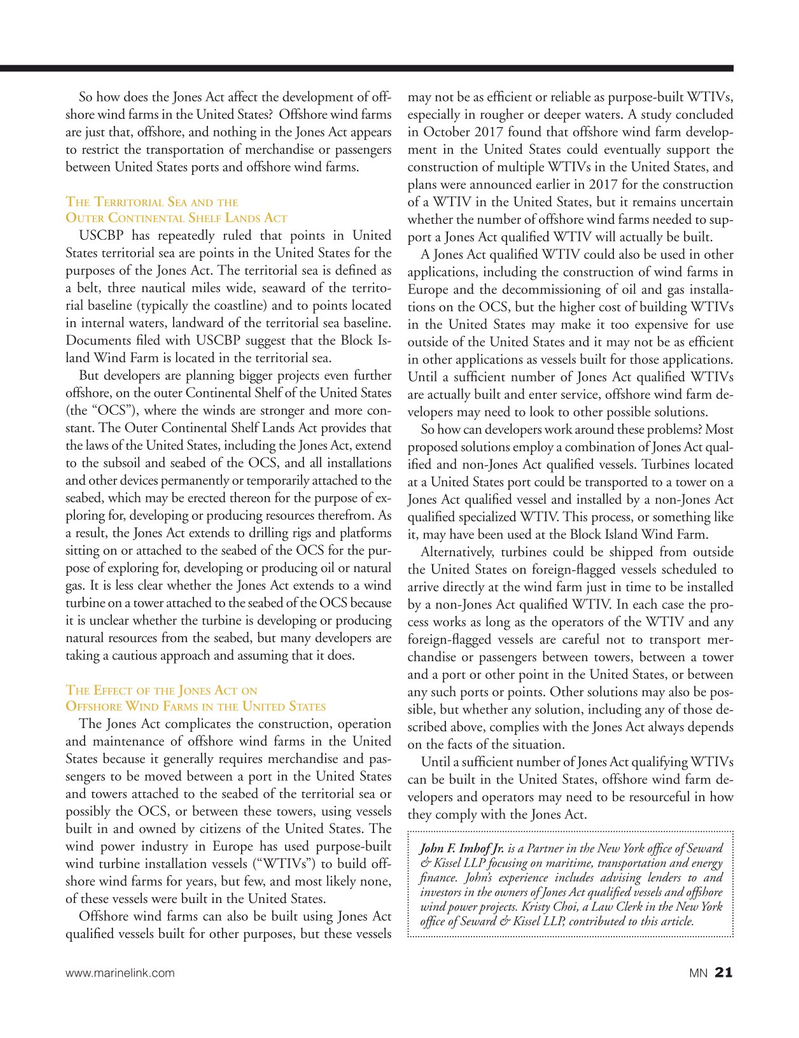
Page 21: of Marine News Magazine (February 2018)
Dredging & Marine Construction
Read this page in Pdf, Flash or Html5 edition of February 2018 Marine News Magazine
So how does the Jones Act affect the development of off- may not be as ef? cient or reliable as purpose-built WTIVs, shore wind farms in the United States? Offshore wind farms especially in rougher or deeper waters. A study concluded are just that, offshore, and nothing in the Jones Act appears in October 2017 found that offshore wind farm develop- to restrict the transportation of merchandise or passengers ment in the United States could eventually support the between United States ports and offshore wind farms. construction of multiple WTIVs in the United States, and plans were announced earlier in 2017 for the construction
T T S of a WTIV in the United States, but it remains uncertain
HE ERRITORIAL EA AND THE
UTER ONTINENTAL HELF ANDS CT
O C S L A whether the number of offshore wind farms needed to sup-
USCBP has repeatedly ruled that points in United port a Jones Act quali? ed WTIV will actually be built.
States territorial sea are points in the United States for the
A Jones Act quali? ed WTIV could also be used in other purposes of the Jones Act. The territorial sea is de? ned as applications, including the construction of wind farms in a belt, three nautical miles wide, seaward of the territo-
Europe and the decommissioning of oil and gas installa- rial baseline (typically the coastline) and to points located tions on the OCS, but the higher cost of building WTIVs in internal waters, landward of the territorial sea baseline. in the United States may make it too expensive for use
Documents ? led with USCBP suggest that the Block Is- outside of the United States and it may not be as ef? cient land Wind Farm is located in the territorial sea. in other applications as vessels built for those applications.
But developers are planning bigger projects even further Until a suf? cient number of Jones Act quali? ed WTIVs offshore, on the outer Continental Shelf of the United States are actually built and enter service, offshore wind farm de- (the “OCS”), where the winds are stronger and more con- velopers may need to look to other possible solutions. stant. The Outer Continental Shelf Lands Act provides that
So how can developers work around these problems? Most the laws of the United States, including the Jones Act, extend proposed solutions employ a combination of Jones Act qual- to the subsoil and seabed of the OCS, and all installations i? ed and non-Jones Act quali? ed vessels. Turbines located and other devices permanently or temporarily attached to the at a United States port could be transported to a tower on a seabed, which may be erected thereon for the purpose of ex-
Jones Act quali? ed vessel and installed by a non-Jones Act ploring for, developing or producing resources therefrom. As quali? ed specialized WTIV. This process, or something like a result, the Jones Act extends to drilling rigs and platforms it, may have been used at the Block Island Wind Farm.
sitting on or attached to the seabed of the OCS for the pur-
Alternatively, turbines could be shipped from outside pose of exploring for, developing or producing oil or natural the United States on foreign-? agged vessels scheduled to gas. It is less clear whether the Jones Act extends to a wind arrive directly at the wind farm just in time to be installed turbine on a tower attached to the seabed of the OCS because by a non-Jones Act quali? ed WTIV. In each case the pro- it is unclear whether the turbine is developing or producing cess works as long as the operators of the WTIV and any natural resources from the seabed, but many developers are foreign-? agged vessels are careful not to transport mer- taking a cautious approach and assuming that it does.
chandise or passengers between towers, between a tower and a port or other point in the United States, or between
T E J A
HE FFECT OF THE ONES CT ON any such ports or points. Other solutions may also be pos-
FFSHORE IND ARMS IN THE NITED TATES
O W F U S sible, but whether any solution, including any of those de-
The Jones Act complicates the construction, operation scribed above, complies with the Jones Act always depends and maintenance of offshore wind farms in the United on the facts of the situation.
States because it generally requires merchandise and pas-
Until a suf? cient number of Jones Act qualifying WTIVs sengers to be moved between a port in the United States can be built in the United States, offshore wind farm de- and towers attached to the seabed of the territorial sea or velopers and operators may need to be resourceful in how possibly the OCS, or between these towers, using vessels they comply with the Jones Act.
built in and owned by citizens of the United States. The wind power industry in Europe has used purpose-built
John F. Imhof Jr. is a Partner in the New York of? ce of Seward & Kissel LLP focusing on maritime, transportation and energy wind turbine installation vessels (“WTIVs”) to build off- ? nance. John’s experience includes advising lenders to and shore wind farms for years, but few, and most likely none, investors in the owners of Jones Act quali? ed vessels and offshore of these vessels were built in the United States.
wind power projects. Kristy Choi, a Law Clerk in the New York
Offshore wind farms can also be built using Jones Act of? ce of Seward & Kissel LLP, contributed to this article.
quali? ed vessels built for other purposes, but these vessels www.marinelink.com MN 21

 20
20

 22
22
